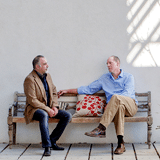What was your first project together?
Jonah Stanford: VolksHouse was the first official MoSA project. The challenge was to design a zero-energy house built for less than typical construction costs by crews with no previous experience with high-performance buildings. We’re proud to say we met every single requirement on the project, including the Passive House certification.
What kind of time commitment does your work involve?
Stanford: We always try to exceed our clients’ expectations on the project, and sometimes that leads to working long hours, but I’d have to say we enjoy it and get as much out of our work as we put into it. We’re partners because we like each other. Sometimes we sort of forget to maintain a personal relationship, but sometimes Vahid and I have lunch or get together after hours to talk about the future of the firm, what is important to us creatively, and different projects.
What types of projects are you interested in?
Vahid Mojarrab: Jonah and I believe shared resources in one infrastructure are the way of the future. The cost is very reasonable as opposed to everyone doing their own photovoltaic or water-catchment systems. We’re also getting tremendous amounts of rehabilitation projects, where people want to improve and apply more energy conservation solutions to existing buildings.
Stanford: For most people in our industry, doing a remodel doesn’t sound all that sexy. But we recognize that to make a dent in energy use, we have to develop ways of reducing it in existing structures. That’s very important to us.
What do each of you think is the other’s biggest strength?
Stanford: Vahid has extensive experience doing large-scale neighborhood planning and subdivision development, which is not something I have a strong background in. That level of understanding of the larger picture is something Vahid brings to the firm that’s pretty tremendous.
Mojarrab: What Jonah really brings is an understanding of mechanical systems and building science. Because of his in-depth knowledge of energy conservation and the Passive House approach, people in our industry look to him for input.
What advice would you give an architect just starting out in the field today?
Stanford: Follow your passion. If you do what you love, you’ll be really good at it.
Mojarrab: It’s a tough profession. As Jonah said, you always have to stay centered.

The Passive House approach is heating up (passively, of course). In 2008, a mere five Passive House-certified homes had been built, but two years later, that number had jumped to 16, with more underway. Plus, 200 consultants had been certified in Passive House design, including MoSA principal Jonah Stanford, a former board president of the Passive House Institute, a nonprofit based in Illinois. In 2011, Stanford and MoSA cofounder Mojarrab created the design for a 495-square-foot home dubbed Small House that could be assembled from recycled materials and prefabricated components and would generate its own water and power supply. Although the design is complete, Small House isn’t yet a reality because of financial constraints. MoSA is currently looking for production funding. “The economics are that we need to get three orders before we start manufacturing,” Stanford says. “We’d like to build a prototype.”

